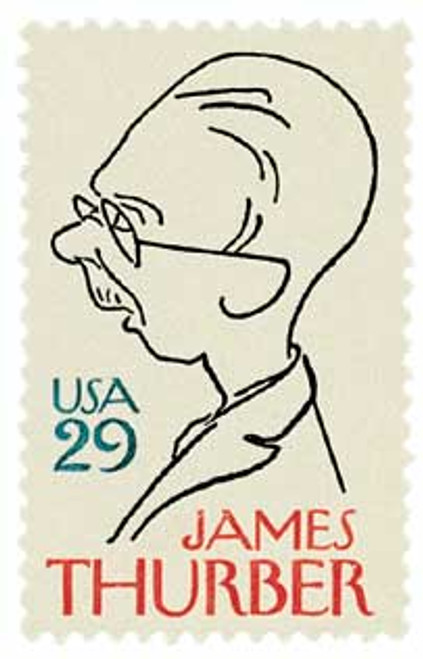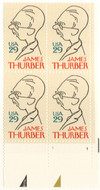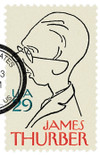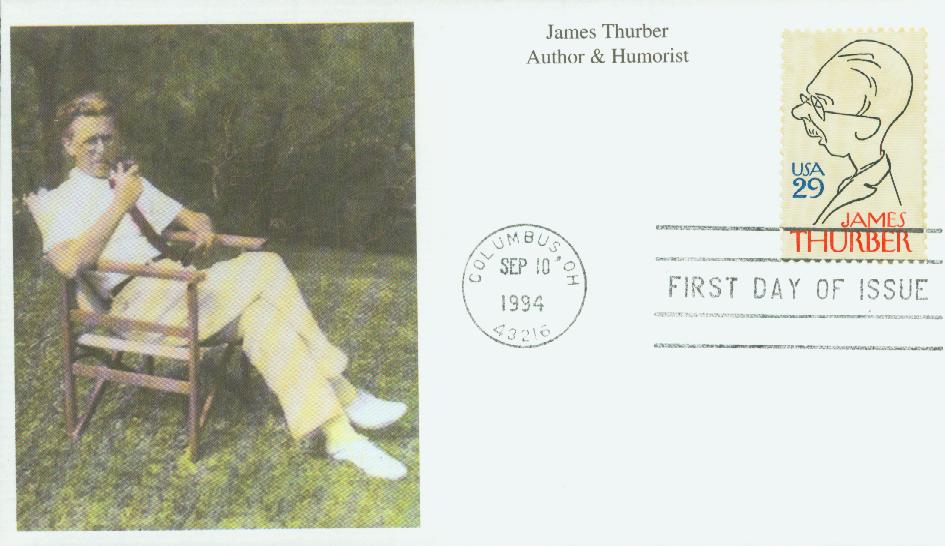
# 2862 - 1994 29c Literary Arts: James Thurber
US #2862
1994 James Thurber
- Commemorates author and cartoonist James Thurber
- 11th stamp in the Literary Arts series
- Features a self-portrait by Thurber
Category of Stamp: Commemorative
Set: Literary Arts
Value: 29¢, First Class Mail rate
First Day of Issue: September 10, 1994
First Day City: Columbus, Ohio
Quantity Issued: 150,750,000
Printed by: Bureau of Engraving and Printing
Printing Method: Lithographed and Engraved
Format: Panes of 50 (10 across, 5 down)
Perforations: 11
Reason the stamp was issued: The stamp was issued in honor of James Thurber’s 100th birthday. It is the 11th stamp in the Literary Arts Series
About the stamp design: The Thurber stamp image is based on a drawing the artist made of himself. It was first published in the 1929 book Is Sex Necessary?
First Day City: The First Day of Issue ceremony took place in Thurber’s hometown, Columbus, Ohio.
About the Literary Arts series: The Literary Arts Series began in 1979 with a John Steinbeck stamp. The objective of the series is to honor American authors from a variety of genres. As the USPS put it, “These skillful wordsmiths spun our favorite tales – and American history along with them.” A portrait of the author is featured on the stamp, with a background that reflects the theme of some of their work. The series honors both well-known and lesser-known authors, making it like an encapsulation of America’s rich and varied literary history.
History the stamp represents:
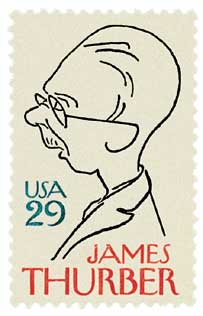
Cartoonist, author, and humorist James Grover Thurber was born on December 8, 1894, in Columbus, Ohio.
When he was a child, Thurber and his brother played a game of William Tell (shooting an apple off someone's head), during which his brother accidentally shot him in the eye. He eventually went almost blind and was unable to play sports or join in other activities. Instead, he found he had a boundless creativity and enjoyed writing.
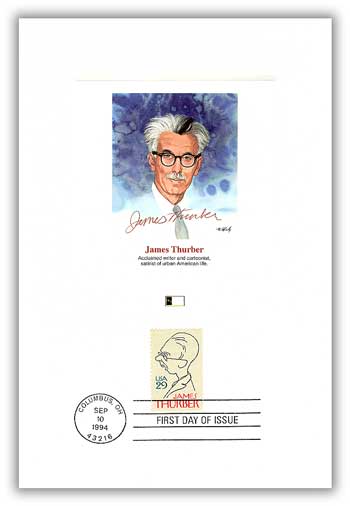
Thurber went on to attend Ohio State University from 1913 to 1918. Never receiving his degree, he went on to work as a code clerk for the Department of State in Washington, DC, and later Paris. From 1921 to 1924, he worked as a reporter for the Columbus Evening Dispatch. In 1924 he moved to France, where he worked for the Paris edition of the Chicago Tribune before returning to New York City in 1926 to work as a reporter for the New York Evening Post.
In 1927, Thurber joined the newly established magazine The New Yorker as a managing editor and staff writer with the encouragement of E.B. White. Three years later, White discovered some of Thurber's drawings in a trash can and convinced him that they were good enough for publication. From then until the 1950s, Thurber wrote and illustrated for The New Yorker.

A prolific writer, Thurber published 31 books, wrote numerous short stories and essays, and even wrote a play. His writings and drawings often concerned men who were frustrated with complaining wives, disobedient children, and boring jobs. They often escaped these pressures with alcohol. Thurber's most famous short story is titled "The Secret Life of Walter Mitty." In this story, Mitty finds relief from his wife by daydreaming. Mitty is always the hero in his dreams, fearlessly saving the day. This story was made into movies in 1947 and 2013.
Click here for more about Thurber and here to read some of his New Yorker work.
US #2862
1994 James Thurber
- Commemorates author and cartoonist James Thurber
- 11th stamp in the Literary Arts series
- Features a self-portrait by Thurber
Category of Stamp: Commemorative
Set: Literary Arts
Value: 29¢, First Class Mail rate
First Day of Issue: September 10, 1994
First Day City: Columbus, Ohio
Quantity Issued: 150,750,000
Printed by: Bureau of Engraving and Printing
Printing Method: Lithographed and Engraved
Format: Panes of 50 (10 across, 5 down)
Perforations: 11
Reason the stamp was issued: The stamp was issued in honor of James Thurber’s 100th birthday. It is the 11th stamp in the Literary Arts Series
About the stamp design: The Thurber stamp image is based on a drawing the artist made of himself. It was first published in the 1929 book Is Sex Necessary?
First Day City: The First Day of Issue ceremony took place in Thurber’s hometown, Columbus, Ohio.
About the Literary Arts series: The Literary Arts Series began in 1979 with a John Steinbeck stamp. The objective of the series is to honor American authors from a variety of genres. As the USPS put it, “These skillful wordsmiths spun our favorite tales – and American history along with them.” A portrait of the author is featured on the stamp, with a background that reflects the theme of some of their work. The series honors both well-known and lesser-known authors, making it like an encapsulation of America’s rich and varied literary history.
History the stamp represents:

Cartoonist, author, and humorist James Grover Thurber was born on December 8, 1894, in Columbus, Ohio.
When he was a child, Thurber and his brother played a game of William Tell (shooting an apple off someone's head), during which his brother accidentally shot him in the eye. He eventually went almost blind and was unable to play sports or join in other activities. Instead, he found he had a boundless creativity and enjoyed writing.

Thurber went on to attend Ohio State University from 1913 to 1918. Never receiving his degree, he went on to work as a code clerk for the Department of State in Washington, DC, and later Paris. From 1921 to 1924, he worked as a reporter for the Columbus Evening Dispatch. In 1924 he moved to France, where he worked for the Paris edition of the Chicago Tribune before returning to New York City in 1926 to work as a reporter for the New York Evening Post.
In 1927, Thurber joined the newly established magazine The New Yorker as a managing editor and staff writer with the encouragement of E.B. White. Three years later, White discovered some of Thurber's drawings in a trash can and convinced him that they were good enough for publication. From then until the 1950s, Thurber wrote and illustrated for The New Yorker.

A prolific writer, Thurber published 31 books, wrote numerous short stories and essays, and even wrote a play. His writings and drawings often concerned men who were frustrated with complaining wives, disobedient children, and boring jobs. They often escaped these pressures with alcohol. Thurber's most famous short story is titled "The Secret Life of Walter Mitty." In this story, Mitty finds relief from his wife by daydreaming. Mitty is always the hero in his dreams, fearlessly saving the day. This story was made into movies in 1947 and 2013.
Click here for more about Thurber and here to read some of his New Yorker work.

